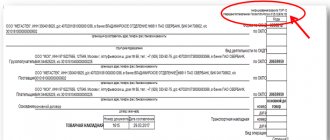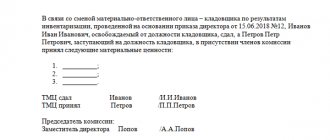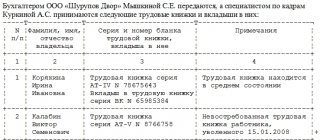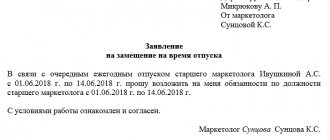Cases of transfer of responsibility when changing employees' positions
Financial liability refers to the obligation of one party to an employment relationship to compensate for possible damage to the other party.
The employer requires the transfer of material assets from one employee to another, if this is provided for by their positions. Positions that may be held by employees from whom this procedure is required :
- Director.
- Chief Accountant.
- HR department employee.
- Department head.
- An employee who bears financial responsibility (for example, chief cashier, warehouse manager).
The reason for changing the financially responsible person may be:
- Dismissal.
- Long-term sick leave care.
- Going on a business trip or going on vacation.
- The previous employee failed in his duties.
About financial responsibility
Financial responsibility is the assignment of responsibilities to an employee for the safety of valuables entrusted to him on the basis of contractual obligations. A liability case occurs when the employer's property is lost. Measures are taken against the violator based on the legislation of the Russian Federation.
Questions from the enterprise may be of the following nature:
- Carrying out the hiring or dismissal of persons who will be responsible.
- Conclusion of contractual obligations regarding responsibility for the safety of materials.
- Organization of inventories, as well as transfer and reception of valuables or audits.
- Determination of information about loss, damage or shortage.
Responsibility for property lies with persons who have concluded employment agreements; this applies to all forms of ownership.
Order to transfer materials to the employer
The order is issued by the head of the organization. The standard form of the document is not established at the legislative level, therefore there is no mandatory unified sample of this document. Its structure, composition and style must comply with the norms of administrative documentation.
Data the document contains:
- Name of company.
- Number and date of compilation.
- Full name and position of the parties to the procedure.
- Reason for transfer of values. For example, due to the dismissal of a previous specialist.
- The date when the procedure will take place.
- List of values that will be transferred.
- Data of workers who will witness the process. If this is an audit company, this must be indicated.
- Full name of the person responsible.
The document is always signed by the current head of the organization, even if he is the one resigning. The signatures of the persons mentioned in the order must also be present. Signatures confirm that employees are familiar with it.
Act of disposal of material assets
After the valuables are written off, they are disposed of. For this purpose, a commission is assembled that evaluates and analyzes the need for disposal, and with an act confirms the implementation of this procedure.
The recycling act is drawn up according to the template established by the company or in free form, handwritten or printed, on plain A4 paper or letterhead. The document must be signed by all members of the commission.
Important! Some categories of materiel must be disposed of in a certain order because they contain harmful substances. Then the disposal is carried out by a specialized company, and before that a disposal agreement is signed with it.
The main part of the act states:
- valuables that are subject to disposal, the cause of defects and malfunctions, the lack of feasibility of repairs;
- Based on the results, it is stated that the specified valuables have been disposed of and no valuables were capitalized during the procedure.
The act is signed by members of the commission and, if necessary, by the head of the company.
We transfer cases
The handover process involves not only a report on the status of work, but also verbal recommendations on how to perform job responsibilities. The order is created to convey the boundaries of responsibility and job responsibilities as accurately as possible. It is compiled by the head of the company in any form.
Information contained in the order:
- Information about the organization.
- Number and date of compilation.
- Full name and position of the receiving and transferring parties.
- The reason and timing of the acceptance and transfer.
- List of cases that will be transferred.
- Composition of the commission and information about its chairman.
- Effective date.
- Additional instructions: conduct an inventory, audit, etc.
- The person responsible for the procedure.
The order to accept cases in connection with dismissal is signed by the general director. The persons mentioned in the order must also sign.
About the order of work
It is not possible to take into account the amount of material assets in full; every manager must understand this. In order to transfer all matters correctly, it is necessary to prepare a transfer act, which displays information about the number and names of assets entrusted to the enterprise.
The audit is carried out on the basis of methods developed by the enterprise.
Sequence of work:
- An administrative document on the creation of a commission is being prepared using a special form No. INV -22. The document must indicate the start and end dates of the work, after which it is familiarized with it to the persons participating in the event.
- Before the actual audit, it is necessary to transfer all invoices about receipts and expenses to the accounting department. This is the basic rule for carrying out work. It turns out that when materials arrive, they must be capitalized, and if the property cannot be used, it must be written off.
- The process itself is carried out in the presence of workers responsible for the materials. There must be resigning persons and newly hired persons.
- All members of the commission are involved in conducting verification activities.
- Based on the results of the inspection, an act is drawn up, which states what exactly was transferred for storage to another employee.
- The act is signed by two parties, the receiving farm and the transferring one. The date of transfer of valuables to another employee must be indicated.
After this, a reconciliation with accounting information is carried out. The documentation must be completed both on a computer and in your own hand. Moreover, the entries must be made correctly, without erasures and corrections are not allowed. You shouldn’t leave empty lines either, and if they still remain, then you need to put a dash.
Certificate of acceptance of documents by the employee
The act of acceptance and transfer of affairs allows you to remove the responsibility of the new employee for the actions of his predecessor. The head of the organization must organize the inspection and create conditions for its conduct. The procedure takes place after the order is issued. The act is drawn up by its parties. The procedure and form of the act are not regulated by law. The document is drawn up in any form on an A4 sheet. Usually it takes the form of an accounting inventory of documents.
Data indicated in the document:
- Date and place of compilation.
- Details of the order on the basis of which cases are transferred.
- Name of company.
- Full name and position of the parties to the procedure.
- List of transferred cases.
- Detected errors in accounting and reporting.
- Information about trial witnesses.
The act of acceptance and transfer of cases is signed by the parties to the transfer and members of the commission. Then he is approved by the head of the company.
Why do you need an acceptance certificate for the transfer of goods and materials?
Let's consider under what circumstances an acceptance certificate is drawn up:
- Discrepancy in numbers and inventory parameters.
- Arrival of goods and materials without documents.
- Transfer of inventory items for safekeeping.
- Transfer of assets by agreement of the commission.
- Transfer of inventory items within an institution between departments or financially responsible employees.
- Transfer of inventory items into temporary storage.
The example document below can be used together with the acceptance certificate for storage (form MX-1).
Receipt of products against an invoice implies the possibility that the goods delivered do not correspond to the quantity displayed on the invoice. However, there are circumstances when the actual quantity of products does not coincide with the declared quantity.
To make a claim to the seller, it is necessary to reflect this circumstance in the acceptance certificate with recording of the identified discrepancies.
Acceptance of some types of goods and materials (for example, equipment) is carried out according to an act, since this is required by the procedure for its acceptance: inspection, determination of serviceability, etc. When sending inventory items for safekeeping, documents are drawn up describing the condition of inventory items, determining the conditions for their placement and appointing a materially responsible employee.
When signing an agreement for the supply of goods, the parties can write into the agreement a clause on the need to draw up an act of acceptance of the products upon transfer to the buyer.
Useful video
The procedure for conducting an inventory and the necessary documents is described in detail in this video:
The article describes typical situations. To solve your problem , write to our consultant or call for free:
+7 (499) 938-43-28 — Moscow — CALL
+7 (812) 467-435-31 — St. Petersburg — CALL
+7 — Other regions — CALL
Grounds for termination of an employment contract with MOL
When dismissing an employee who is a materially responsible person, the general procedure for terminating employment relations, stipulated by Chapter 13 of the Labor Code of the Russian Federation, applies. However, the presence of material liability regulated by an employment contract or an additional agreement to it still imposes its own specifics.
If we are guided by Article 77 of the Labor Code of the Russian Federation, the dismissal of an employee who is a MOL can be carried out on the following possible grounds:
- The parties reached an appropriate agreement (Article 78 of the Labor Code of the Russian Federation).
- The employment contract has expired (Article 79 of the Labor Code of the Russian Federation).
- The employee’s own desire (personal initiative), which is stipulated by Article 80 of the Labor Code of the Russian Federation.
- Personal initiative of the management of the organization (employer), as provided for in Articles 71 and 81 of the Labor Code of the Russian Federation.
- The employee changed employers or took an elected position. Such a reason is allowed if the employee himself asked for it or, alternatively, gave his consent to it.
- The employee refused to continue working due to a change in the ownership of the employing company's assets or its reorganization (Article 75 of the Labor Code of the Russian Federation).
- The citizen refused to continue working with this employer due to a change in the parameters of the employment contract previously determined by the parties (clause 4 of Article 74 of the Labor Code of the Russian Federation).
- The citizen refused to be transferred to another job if such a transfer was assigned to him in accordance with a proper medical report. Another reason in this context is that the employer was unable to provide such an employee with appropriate employment. Such reasons are provided for in parts 3-4 of Article 73 of the Labor Code of the Russian Federation.
- The employer changed his geographical location, and the employee refused to follow him for the subsequent performance of work duties (Part 1 of Article 72.1 of the Labor Code of the Russian Federation).
- Circumstances the occurrence of which does not depend on the will and desire of the parties. The basis is Article 83 of the Labor Code of the Russian Federation.
- When drawing up an employment contract, certain rules regulated by the Labor Code or other federal law were violated, which resulted in the impossibility of further work. The basis is Article 84 of the Labor Code of the Russian Federation.
- Other grounds stipulated by the current legislation of the Russian Federation.
Thus, the financially responsible person terminates the employment relationship on general legal grounds.
The specificity of MOL's departure is that before his dismissal he must officially transfer (return) the assets entrusted to him to the employer. This must be done 14 days before the last working day.
If an employee leaves on his own initiative (Article 80 of the Labor Code), he sends a corresponding statement to the employer 14 days before the upcoming departure (but no later).
We suggest you familiarize yourself with the ex-husband does not pay alimony, the bailiff cannot bring him to criminal responsibility
During this two-week period, the employee, who is the financially responsible person, transfers the entrusted assets to the employer. In this case, the fact that the parties have no mutual claims is formalized by an appropriate act of the employer.
If an employee registered as a materially responsible person resigns from the organization on his own initiative, the general dismissal regulations provided for in Article 80 of the Labor Code are applied.
The fact that this employee is responsible for the inventory items entrusted to him certainly imposes its own specifics on the dismissal procedure.
The corresponding dismissal procedure is implemented as follows:
- Step 1. An application from the retiring employee is sent to the management of the employing organization.
The resigning citizen must submit such paper 14 days before his upcoming departure (no later). However, the parties have the right to stipulate a different period for filing the appropriate notice.
A two-week period is required to transfer all cases, perform an inventory (audit) of inventory items, and select another candidate for the vacancy.
- Step 2. Conducting an audit of entrusted assets (inventory and materials).
The audit is carried out by a special commission on the basis of a corresponding order from the management of the organization. Inventory is stipulated by an additional agreement defining the employee’s financial responsibility.
This procedure is carried out with the participation of both parties – the employee (materially responsible person) and the employer’s representative.
Relevant assets are subject to identification, careful recalculation and detailed verification. Further actions are determined by the results of this audit.
- Step 3. Transfer and acceptance of entrusted assets.
The procedure for acceptance and transfer of inventory items is carried out if, based on the results of the audit, there are no inconsistencies, and is formalized by drawing up an appropriate act.
The document is signed by the retiring employee, a representative of the employing company, as well as a new employee who has filled the vacancy.
- Step 4. The employer draws up an administrative act (order) approving the dismissal of the financially responsible person at his own request.
The paper is drawn up according to the T-8 template and contains all the necessary information about this disposal.
- Step 5. Providing the retired employee with labor documentation.
The employer issues him a work book, documentation of earnings, a 2-NDFL certificate, as well as other papers provided upon a separate request.
- Step 6. Carrying out settlements (mutual settlements) with the retired employee.
The procedure is carried out simultaneously with the provision of labor documentation to him. The dismissed person is given a salary, as well as compensation for unused vacation. Calculation of payments upon dismissal is carried out by filling out the calculation note T-61.
It is these payments that are considered mandatory if the employee resigns on his own initiative.











